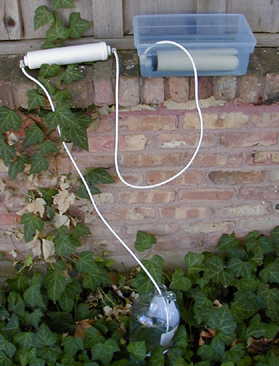Gravity & Siphon Filter Instructions
Using an Un-Vesselled Candle Siphon

(SK101, SK102, SK103, SK105)
Before operation, soak the ceramic candle thoroughly.
The operation is very simple. Put water to be filtered in a container — a flat container big enough for the filter cartridge to lie horizontally works best — drop the filter cartridge into the water, let it soak until it won't float, then suck on the end of the tubing. When you get water in your mouth, drop the tube into another container a few inches lower than the first and clean water will flow from the end of the tube into your container.
The rate of flow is pretty spectacular. Three gallons per hour is a reasonable expectation, and these filters have done better than that in our tests. It's faster than a stainless steel four-candle gravity filter and it will run on nature's energy as long as you keep water in the top container. And, get this, the ceramic candle filter acts like a lamp wick. It will suck every drop of water from the top container, then start working again without priming if you pour more water into the container.
Adding an Inline Carbon Filter to an Un-Vesselled Candle Siphon
Start the Candle Filter Siphon without the inline filter attached, as above, then simply plug its outlet tube into the inline filter once the newly filtered water has started flowing. This will add high quality carbon filtration to the ceramic's bacterial filtration.
Using a Vessel-Style Siphon Filter

Model 77 Siphon
Before operation, soak the ceramic candle thoroughly, as described above. Then install the cartridge in the vessel.
Stand the filter unit next to the dirty water container and drop the “In” tube (black) into the water. Suck on the “Out” tube (white) until you get water in your mouth, then place the “Out” tube into a second vessel that is lower than the first. Water will continue to flow through the filter until the top container is empty.
I won't pretend that I've run exhaustive tests on the two models, but the production rate seems to be about the same. This surprised me a little. I expected un-vesseled candle filter to be the faster performer. All things considered, however, the un-vesselled models are less expensive, simpler to use and easier to get going.
Site Index
Filtration Systems
- Aeration for Iron & Sulfide
- Backwashing Filters
(whole house & well units)
- Chlorine & Chemical Injectors
- Countertop Water Filters
- Emergency Filters
- Garden Hose Filters
- Reverse Osmosis, Residential
- Reverse Osmosis, Commercial
- Shower Filters
- Specialty Filters
- Ultraviolet Systems
- Undersink Filters
- Water Softeners
- Whole House Filters
Cartridges
Parts
- Replacement Parts
- Faucets
- Filter Media
- Fittings
- Housings
- O-rings
- Pumps
- Pura UV
- R.O. Parts
- R.O. Tanks
- R.O. Booster Pump
- VIQUA UV